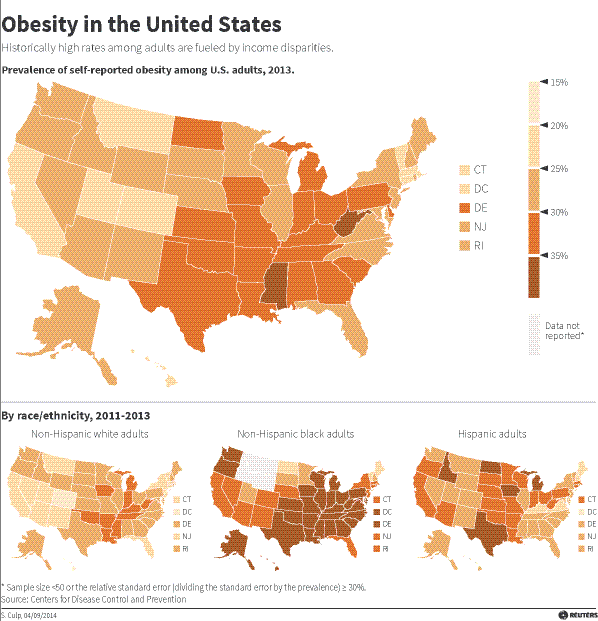Study Show American Waistlines Continue to Expand
| Jan Dizon | | Sep 17, 2014 09:35 PM EDT |
(Photo : Reuters)
A study published in the Journal of the American Medical Association on Tuesday reports that, although the obesity rate in the United States has stabilized, American waistlines still continue to get larger every year.
According to data gathered by the Centers for Disease Control (CDC) and the National Health and Nutrition Examination Survey (NHANES), American waistlines grew more than an inch among different demographics over the last decade, making the national average among adults 39 inches.
Like Us on Facebook
Meanwhile, numbers for the Body Mass Index (BMI), which is determined by weight-to-height ratio and is used to help measure obesity, have stabilized even though belly circumference continues to expand.
Researches said that it is unclear why waistlines are getting bigger while BMI has flat-lined. Possible contributors could be sleep problems, certain types of medication, lack of exercise and proper diets, and an aging population.
"As we age, heavy muscle is lost and we gain more fat," said David Heber, director of UCLA Risk Factor for Obesity Clinic.
The obesity and abdominal circumference study was based on data collected by NHANES to assess the weight of 32,816 individuals from across the United States between the years 1999 and 2012. The people surveyed were 20-years-old and above, with the national average for ages of adults during that time being 45-years-old.
Experts found that adult waistlines grew from an average of 37.6 inches in 2000, to 38.8 inches in 2012, to the present number which venture dangerously close to what is considered abdominal obesity - 40.2 inches for men, and 34.6 inches for women.
In fact, at 37.8 inches, the national average waistline for American women is already considered obese.
According to health care experts, carrying around excess stomach fat is extremely dangerous. People who suffer from excess fat in the belly area put themselves at greater risk for heart disease, sleep apnea, diabetes, and high cholesterol.
Tagsobesity, americas waistlines, obesity in america, U.S. obesity, expanding waistlines, excess weight, overweight
©2015 Chinatopix All rights reserved. Do not reproduce without permission
 FDA Approves Contrave To Treat Obesity
FDA Approves Contrave To Treat Obesity 'Fingerprinting' Cell Metabolism to Help Obesity, Diabetes Studies
'Fingerprinting' Cell Metabolism to Help Obesity, Diabetes Studies Obesity in Texas on the Rise Again
Obesity in Texas on the Rise Again Parents Believe Overweight Kids Are Healthy
Parents Believe Overweight Kids Are Healthy Intensive Lifestyle Counseling Recommended For Overweight and Obese Americans
Intensive Lifestyle Counseling Recommended For Overweight and Obese Americans Junk Food's Addictive; that's Why You Can't Stop Eating It
Junk Food's Addictive; that's Why You Can't Stop Eating It
EDITOR'S PICKS
-

Did the Trump administration just announce plans for a trade war with ‘hostile’ China and Russia?
-

US Senate passes Taiwan travel bill slammed by China
-

As Yan Sihong’s family grieves, here are other Chinese students who went missing abroad. Some have never been found
-

Beijing blasts Western critics who ‘smear China’ with the term sharp power
-

China Envoy Seeks to Defuse Tensions With U.S. as a Trade War Brews
-

Singapore's Deputy PM Provides Bitcoin Vote of Confidence Amid China's Blanket Bans
-

China warns investors over risks in overseas virtual currency trading
-

Chinese government most trustworthy: survey
-

Kashima Antlers On Course For Back-To-Back Titles
MOST POPULAR
LATEST NEWS
Zhou Yongkang: China's Former Security Chief Sentenced to Life in Prison

China's former Chief of the Ministry of Public Security, Zhou Yongkang, has been given a life sentence after he was found guilty of abusing his office, bribery and deliberately ... Full Article
TRENDING STORY

China Pork Prices Expected to Stabilize As The Supplies Recover

Elephone P9000 Smartphone is now on Sale on Amazon India

There's a Big Chance Cliffhangers Won't Still Be Resolved When Grey's Anatomy Season 13 Returns

Supreme Court Ruled on Samsung vs Apple Dispute for Patent Infringement

Microsoft Surface Pro 5 Rumors and Release Date: What is the Latest?










